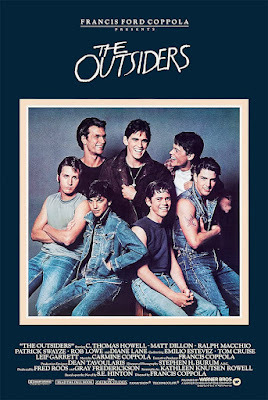From Your First Cigarette to Your Last Dying Day: “The Outsiders”
 When I was growing up, youthcliques and gangs were a hot topic. West Side Story made it big onBroadway in 1957, and became a must-see film in 1961. It was five years laterthat S.E. Hinton (Susie to her friends) published a Young Adult novel called TheOutsiders. It looked squarely at the lives of teenagers who, because oftheir looks or family situations, were regarded as social outcasts in theirOklahoma hometown. In the world of this story, teens are divided into twogroups. The Socs (pronounced “soshes”) were more affluent, dressed better, andhad cool cars with fins. The Greasers worn grubby jeans and T’s, startedsmoking at a very young age, and didn’t have much use for school. Hinton—who,remarkably, published the novel when she was sixteen—empathized almost entirelywith the Greasers, whose underlying pain and sensitivity she understood. Thenarrator of her novel, Ponyboy Curtis, is a fourteen-year-old who—in theabsence of parents—shares strong bonds of loyalty with his three olderbrothers. Though he's at the fringes of some brutal situations, like a rumblein a local park, he’s basically a good kid who’s polite to girls, lovessunsets, and ruminates over a poem by Robert Frost, “Nothing Gold Can Stay.”
When I was growing up, youthcliques and gangs were a hot topic. West Side Story made it big onBroadway in 1957, and became a must-see film in 1961. It was five years laterthat S.E. Hinton (Susie to her friends) published a Young Adult novel called TheOutsiders. It looked squarely at the lives of teenagers who, because oftheir looks or family situations, were regarded as social outcasts in theirOklahoma hometown. In the world of this story, teens are divided into twogroups. The Socs (pronounced “soshes”) were more affluent, dressed better, andhad cool cars with fins. The Greasers worn grubby jeans and T’s, startedsmoking at a very young age, and didn’t have much use for school. Hinton—who,remarkably, published the novel when she was sixteen—empathized almost entirelywith the Greasers, whose underlying pain and sensitivity she understood. Thenarrator of her novel, Ponyboy Curtis, is a fourteen-year-old who—in theabsence of parents—shares strong bonds of loyalty with his three olderbrothers. Though he's at the fringes of some brutal situations, like a rumblein a local park, he’s basically a good kid who’s polite to girls, lovessunsets, and ruminates over a poem by Robert Frost, “Nothing Gold Can Stay.”Following his acclaimedrelease of two Godfather films and Apocalypse Now,director-producer Francis Ford Coppola turned his talents to The Outsiders,after a librarian and her students at Lone Star Elementary School in Fresno,California brought the novel to his attention. Now his goal was to find atroupe of very young actors who could embody Hinton’s characters on thescreen. C.Thomas Howell, then fifteen, appealingly played Ponyboy. Hisbrothers—the tortured Dally and the take-charge Darrel—were Matt Dillon andPatrick Swayze. Other rising young actors in the cast were Rob Lowe, EmilioEstevez, and (in a small part) Tom Cruise. A key role, that of a very youngGreaser who proves himself both a hero and a martyr, was played by RalphMacchio, just before he became The Karate Kid. (He apparently was 20 at thetime, but convincingly looks about 13.) The film’s final moments, in which aclose-up of Macchio is superimposed upon an image of Ponyboy writing his storyis either hugely poignant or hugely corny, or both at once.
As a movie, The Outsiders makesan interesting contrast to the much-beloved West Side Story. Itsrivalries are purely social rather than ethnic. West Side Story ofcourse pits Puerto Rican immigrants against white kids whose ancestry isprobably not far removed from Ellis Island. But in The Outsiders thedivide is almost entirely along economic lines. And, of course, there’s nosinging and dancing in this film. Being a Greaser doesn’t seemnearly as much fun as being a Jet. The rumble in which most of the charactersparticipate is less picturesque than grubby, fought in the mud during a drivingrain.
At my L.A. public high schoolthere was not the kind of stark social divide portrayed in the film. Though Inever heard anyone called a Greaser, we definitely had Soshes, who vied to gainmembership in exclusive social clubs. A more innocent version of the kind ofdivide portrayed in The Outsiders shows up in both the stage (1971) andthe film (1978) versions of a box-office hit, Grease. Hinton’s novel could have been aninspiration for that show, but I suspect there was something in the culturethat inspired both projects. Ironically, a version of The Outsiders landedon Broadway in 2024, taking home the Tony Award for best musical.
Beverly in Movieland
- Beverly Gray's profile
- 10 followers



